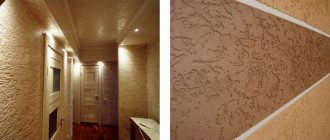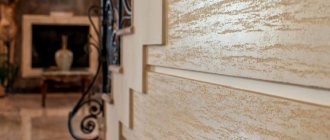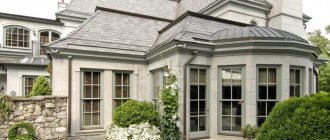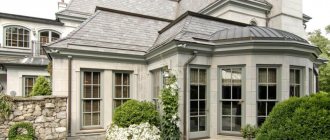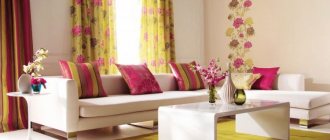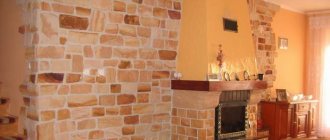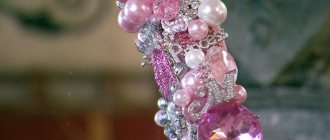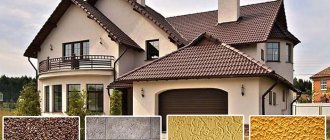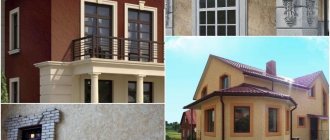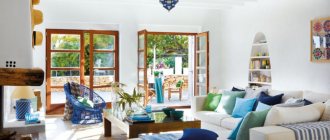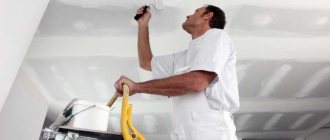Plastering bark beetles in an apartment is primarily a practical solution. There are many options for textured coatings with different textures and compositions. This is a good decor option for different rooms: hallway, kitchen or even balcony. You can experiment with color or even combine two shades - this color combination will look unusual and bright.
Characteristics of the "Bark Beetle"
The material does not require high qualifications when working with it, is in no way inferior to other finishing materials during operation and gives the house an exquisite appearance. In addition, its texture allows you to hide defects in wall coverings.
The base of the plaster is gypsum or acrylic. Packaged in the form of a ready-to-use mixture or powder. Marble chips with a grain size of 0.08-0.35 cm are added to the mixture. This component gives the coating a grooved relief.
Most often, this plaster is used to cover the façade of a house. The color of the material is light shades, so after plastering the facade is painted, choosing a color to taste.
Concrete tiles
Facade concrete tiles look beautiful. For any architectural buildings, be it the external walls of a country cottage or the facade of a country house, this will be an excellent solution. High quality, looks very similar to natural stone. An even texture will make it possible to do the work neatly. A variety of colors will allow you to decorate your home to your taste.
Includes:
- sand;
- cement;
- plasticizing additives;
- mineral-based powder, which is a replacement for ash and cement.
Concrete tiles are a very high quality product. In appearance and properties it resembles natural stone. Unknowing people will not be able to feel the difference even by touch. The feeling that you are holding natural raw materials in your hands is due to the uneven surface. Relief is achieved under the influence of high-frequency vibration (the mold filled with raw materials is placed on a vibrating table). To achieve a higher quality of installation, you need to choose the most even rectangles.
Material advantages
- Mechanical strength and no harm to the environment. The starting components of plaster are only natural materials.
- Light weight. Reduces the load on the supporting structures of the house due to light mineral fillers.
- The ability not to lose strength, moisture-proof and color characteristics over a long period of operation.
- Fire resistance, ability to withstand open fire.
- Variety of colors. Choosing the right bark beetle color for the facade will not require significant labor costs. Ability to resist mold fungi.
- Attractive prices and a wide range of pricing solutions.
How to choose the right insulation thickness
In order not to make a mistake with the choice of insulation thickness, you should use special programs. For example, there are calculators online for calculating the thickness of thermal insulation. One of them is here. It takes into account many parameters, and even relies on the climatic conditions of various Russian cities.
The proposed fields must be filled in, indicating the desired temperature in the room, the type of room and structure, and the dimensions of the building. By clicking the “perform calculation” button, the program will display the desired figure.
In general, there are standards for each region.
· Moscow – 120 mm
Chelyabinsk – 130 mm
Kemerovo – 140 mm
· Sochi – 90 mm.
Disadvantages of the material
- If the coating is damaged, it is very difficult to repair it. To do this, it is necessary to remove the damaged layer of plaster and reapply it.
- Application technology requires professionalism. In this case, a special trowel is used.
- It is quite difficult to remove contaminants from a surface plastered with “Bark Beetle” and having a complex topography.
Varieties of "Bark beetle"
Manufacturers offer two types of bases - gypsum and acrylic.
The acrylic-based mixture is applied using special technologies and requires a professional approach. This composition fits well on concrete and surfaces made of cement-bonded particle boards.
Painting acrylic-based plaster requires the use of computer technology and special machines. May contain mineral chips, the grain size of which is 0.1-3.5 mm.
Manufacturers guarantee the service life of such coatings for at least 15 years. After drying, it becomes resistant to adverse external influences.
The color of the coating is selected in advance, after which painting is not required. However, applying such a coating requires special knowledge and experience.
Gypsum-based bark beetle is more economical and less difficult to use. To work, you need to prepare a solution by mixing the dry composition with water.
It is applied to the walls manually, and no high qualifications are required, that is, finishing the facade with your own hands is quite simple. The material is durable, and its price is not high.
There are two varieties of bark beetle. The binder can be silicate or silicone compounds. The first is characterized by resistance to microorganisms and vapor permeability. The second is chemical resistance.
Briefly about the main thing
Decorative plasters are mixtures that are used at the finishing stage of repair work. With their help, it is possible to create coatings that are unique in their properties and can imitate natural stone, wood, textiles, and raindrops. The right composition will help recreate the appearance of ancient Venetian buildings. Plasters are applied to any base that has been previously cleaned and treated with a primer. You only need to level the walls before using the Venetian.
Ratings 0
Coloring
In the case of gypsum-based plaster, any coloring substance can be added to the dry mixture. If the plaster is acrylic-based, then painting should be done with great care, otherwise the color may be overly saturated.
After plastering, the surface can be coated with enamel on a base similar to plaster. Today, brown, beige and yellow colors are popular.
However, the color of the house should be in harmony with the color scheme of the entire site. Experts recommend using several colors when painting your home, including gray and green.
Popular manufacturers
Ceresit, Baumit and Dufa are the most popular among consumers. The use of plaster from these manufacturers does not require high qualifications and time spent on preparing the mixture.
The plaster of the Unis consortium, which also includes domestic manufacturers, is particularly successful. It is produced both in the form of a dry mixture and in a ready-to-use form. Resistant to fungi, ultraviolet radiation and frost.
Selection of paint and application methods
Manufacturers of finishing materials offer a ready-made color palette of bark beetle plaster for facades. The gray and white colors of the facing material are intended for finishing work before painting. Painting façade plaster is carried out in three ways, differing in the technique of applying the dye. The main condition for obtaining the desired result is compliance with the rules for applying each type of paint.
- Tinting the mixture:
Only acrylic plaster is suitable for this painting method. Adding a coloring pigment to the finished plaster solution before applying it to the wall allows you to distribute the paint evenly and is considered the easiest way to paint bark beetle. For uniform coloring, it is important to strictly adhere to the proportions of the solution and pigment over the entire area of application of the finishing material. To create a better surface, it is necessary to apply an additional layer of paint after the finishing material has completely dried;
- Painting in two layers:
Applying paint in two layers will allow you to achieve a better and more durable coating. The color of the required shade is added to the paint. Thick application of the first layer is carried out so that the paint can penetrate into all the characteristic recesses of the decorative plaster. Excess paint is removed with a dry sponge or roller. Applying a second layer serves a decorative function and does not require complete painting of the recesses. To emphasize the surface structure, use a roller with a small amount of paint.
- Application of tinted primer:
The method of applying tinted primer is similar to the two-layer painting method. The difference is that a primer mixture is used instead of paint. Application of a primer contributes to the effective protection of facade plaster; the disadvantages of this method of painting include dull colors obtained as a result of applying a tinted primer. To obtain a better result, the primer should be applied twice.
There is no special paint designed for painting bark beetle plaster. The most common materials used for painting building facades include:
- Alkyd - resistant to natural phenomena, low cost, due to its specific odor, suitable only for outdoor work.
- Oil - has bright and saturated colors, but the lack of vapor conductivity and instability to alkaline substances significantly reduce the quality of the coating.
- Acrylic - odorless, environmentally friendly, creates a durable coating, and has vapor-proof properties.
Consumption rates
Before work, you should calculate the amount of mixture required as accurately as possible. Otherwise, the excess will become unusable, and the deficiency will lead to a disruption in the texture when the solution is re-applied.
It should be noted that if the wall is uneven, then the layer of plaster must be increased. The packaging of the mixture always indicates the approximate consumption, on average it is up to 3 kg per 1 sq. m. m of surface.
Coating technology
Finishing the facade is the final and most important stage of construction, because the impression of the house depends on it.
Stages of work:
- Installing beacons and leveling the surface.
- Primer. A solution with increased adhesion is considered the best.
- Facing. This is done with a spatula. Preference should be given to coarse-grained compounds
- Areas not to be covered are covered with masking tape.
- Creation of the required texture. It is created with a special grater, which is used to process the wet surface of the plaster. The process is similar to conventional puttying, but in our case the solution is “smeared” until grooves form. If it sticks to the grater, the mixture must be allowed to dry.
- Varnish coating. Gives the surface an attractive appearance and protects it.
How to remove old plaster?
It is necessary to remove old plaster only in case of poor adhesion to the base. You need to make sure what type of plaster is: cement or lime? Limescale must be removed without regret. If the cement holds tightly, there is no need to remove it.
Removing old plaster
Tip: Check the quality by lightly tapping the wall with a hammer. If the sound is dull, it means the layer has fallen behind the brick base and will fall off over time. Such areas must be removed and plastered again.
Plaster is removed in two ways:
- manually with a chisel, hammer, scraper, spatula;
- mechanical hammer drill or grinder with a diamond wheel.
We resort to using a hammer drill
In both cases it is necessary to get to the base. The final stage is cleaning with metal brushes manually or with a grinder, removing dust with a wet cloth or vacuum cleaner.
Finishing
Bark beetle finishing is mainly used in low-rise construction. This finishing method allows you to give the building a unique look.
To make an error-free choice of coating technology and design, it is recommended to familiarize yourself with photos of beautiful bark beetle facade decoration posted on the Internet. For example, giving the house an "antique" feel. To do this, use plaster of dark colors and create the appropriate surface texture. The effect can be enhanced by a brick plinth, columns and a wide staircase.
A classic design will require understated elegance and simplicity. The coating is carried out with acrylic plaster of light colors. A tiled roof and brick gazebos will complete the impression.
For small buildings, a combination of plaster with natural materials is recommended. For example, inserts made of wood and natural stones harmonize well with a tiled roof, flower beds and shell paths.
Designers recommend plastering all loggias and terraces in the same way, but using different colors. This will highlight every architectural detail of the building and emphasize its individuality. At the same time, they stick to brown and light beige shades. Each floor of the house can be painted in different colors, and a wide staircase with carved railings will give the building an original and attractive look.
Useful tips
If you dream of a home with impeccable style, the following recommendations will be useful:
- If your house has a traditional look , in most cases it is assumed that a roofing material that is darker than the façade finish will be chosen (although the opposite solution is not prohibited). If the dominant color seems bland, you can dilute it with bright accents.
- For a home in a classic style, bright and provocative colors are prohibited. The combination of white and dirty pink tones for facade decoration has a noble sound; white and hot pink will remind you of a bowl of marshmallows.
